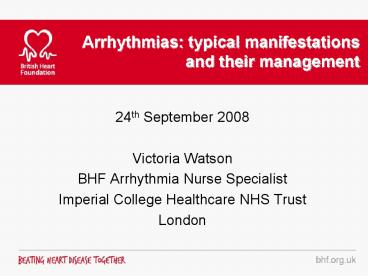Arrhythmias: typical manifestations and their management - PowerPoint PPT Presentation
1 / 34
Title:
Arrhythmias: typical manifestations and their management
Description:
Screening for at risk patients. Rapid assessment of syncope ... Cardiac assessment (echo, exercise test, prolonged ECG monitoring, angiogram, cardiac MRI etc. ... – PowerPoint PPT presentation
Number of Views:303
Avg rating:3.0/5.0
Title: Arrhythmias: typical manifestations and their management
1
Arrhythmias typical manifestations and their
management
- 24th September 2008
- Victoria Watson
- BHF Arrhythmia Nurse Specialist
- Imperial College Healthcare NHS Trust
- London
2
National Service Framework
3
National Service Framework for Arrhythmias
- Assessment by Arrhythmia Specialist
- Sudden Cardiac Death
- Screening for at risk patients
- Rapid assessment of syncope
- Implantable Defibrillators by NICE guidelines
- Patient Support and Family screening
- Atrial Fibrillation-NICE GUIDELINES
- Stroke Prevention
- Therapy for symptoms
- Biventricular devices for Heart Failure
4
Symptoms
- Irregularly irregular pulse
- Syncope
- Pre-syncope, dizziness
- Shortness of breath
- Fatigue
- CVA
- Palpitations
- NONE
5
Assessment
- Duration,frequency,
- Rate/rhythm-tap out
- Onset/offset
- Associated symptoms
- Cardiac history
6
Ventricular Beats- Ectopy
- Characteristics of PVC's (Huff, 9-3, 6, 10)
- PVCs dont have P-waves unless they are
retrograde (may be buried in T-Wave) - T-waves for PVCs are usually large and opposite
in polarity to terminal QRS - Wide (gt .16 sec) notched PVCs may indicate a
dilated hypokinetic left ventricle - Every other beat being a PVC (bigeminy) may
indicate coronary artery disease - Some PVCs come between 2 normal sinus beats and
are called interpolated PVCs
The classic PVC note the compensatory pause
Interpolated PVC note the sinus rhythm is
undisturbed
7
Premature atrial ectopic beats
8
The diagnostic process
- History
- Examination
- ECG
- Blood results
- Cardiac assessment (echo, exercise test,
prolonged ECG monitoring, angiogram, cardiac MRI
etc.)
9
- TREATMENT
- DRUG THERAPY
- CARDIOVERSION
- ELECTROPHYSIOLOGY STUDIES
- ABLATION
- ICDs
- BRADY/ TACHY PACING
10
Atrial Fibrillation-irregular,no definite p waves
11
Demographics
12
Causes of AF
- Hyperthyroidism
- Intercurrent Illness
- Especially LRTI, UTI in elderly
- Perioperative AF
- Alcohol- probably genetic predisposition
13
Causes continued
- Any STRUCTURAL heart disease- especially those
associated with - LA enlargement
- LVH
- Reduced systolic function
- Valvular (especially mitral) heart disease
- Hypertensive Heart disease
- Cardiomyopathy of any cause (up to 30)
- Hypertrophic cardiomyopathy
14
Rate vs Rhythm Control
- Consider both in all patients
- Rhythm control the preferred strategy in
- Young patients (lt65yrs)
- Highly symptomatic patients
- Patients who develop heart failure with AF
- Newly diagnosed AF or AF with clear precipitant
15
Safest Drug in the Management of Atrial
Fibrillation
- Electricity!
- Cardioversion- Must have 4 INRS gt2 pre-procedure
- BUT-
- less successful the longer duration of AF with
dilated left atrium - 50 of patients will have reverted within a year
16
Drugs rate control
- NICE recommend-
- Beta blocker/ calcium channel blocker for rate
control - Digoxin only for sedentary patients
17
Drugs to chemically cardiovert
- Flecanide/propafenone - NOT in structural heart
disease - Best drug to chemically cardiovert
- But electrical cardioversion is more effective
and safer - Sotalol
- Otherwise less effective and less well tolerated
than standard beta blocker - Amiodarone -last resort
18
Risk factors for stroke in Atrial Fibrillation
- NICE 2006
- Anticoagulation guidelines warfarin vs
aspirin - High risk
- Ischaemic stroke/TIA
- Age 75
- Hypertension
- Diabetes
- Vascular disease
- Valve disease
- Heart failure
- Moderate risk Age 65 with no high risk factors
- Age lt75 with hypertension, diabetes or
vascular disease - Low risk Age lt65 with no moderate or high risk
factors
19
Anticoagulation
- All studies show superiority of standard dose
warfarin (INR 2-3) over any other strategy in all
groups - The beneficial effect is even more marked in the
elderly (gt75) where the risk of embolic stroke
climbs significantly - But clinicians remain circumspect about using
warfarin in the real world (especially in the
elderly)
20
Effects of anticoagulation rates on stroke rates
21
Supra ventricular tachycardia-narrow complex,
rapid, p waves may/may not be present
22
AVNRT
23
Atrioventricular nodal re-entry
tachycardia
- Most common SVT
- There is no disease predisposition
- More prevelant in Women
- Narrow complex, 120-250 bpm
- Typically 3rd and 4th Decade
- Recurrent palpitations
- RAPID onset and RAPID offset
- vagal maneuvers to terminate the arrhythmia
24
Cardiac Catheter Ablation
- Safe low risk procedure, Complication rate of
1-2, mortality 1-2/1000 - Effective, a CURE
- Ablation Therapy for Arrhythmias
- AVNRT / AVRT / Atrial Flutter gt98 Success Rate
- Atrial Tachycardia / VT gt90 Success Rate
- Atrial Fibrillation 70 Success Rate
25
(No Transcript)
26
Atrial Flutter
- ECG regular saw tooth flutter waves
- Ventricular rate will be a 300bpm, 150bpm, 75bpm
and regular due to pathway - Possible will predispose to A fib
- Flutter ablation ablate pathway 98 success
27
Bradycardia
- Drugs
- Age
- Hypothyroidism
- Ischaemia
- Excess vagal tone
- Negative chronotropes
- Hyperkalaemia
28
(No Transcript)
29
At Risk Patients
- Heart failure- reduced systolic function
- Ischaemic Heart disease
- Post myocardial infarction
- Cardiomyopathy of any cause
- (Hypertrophic cardiomyopathy,dilated
cardiomyopathy)
30
Ventricular Tachycardia (Monomorphic)
31
Rhythm Strip During Episode of Sudden Death
32
ICD-Key device system components
33
Implantable cardioverter-defibrillators
(ICDs) Current NICE guidance
34
Rapid Access Arrhythmia Clinic
- Arrhythmia Nurses- 0207 8862378
- Victoria Watson
- Victoria.watson_at_imperial.nhs.uk
- 07768953414
- Andrea Grieger
- Andrea.grieger_at_imperial.nhs.uk
- 07768980832































